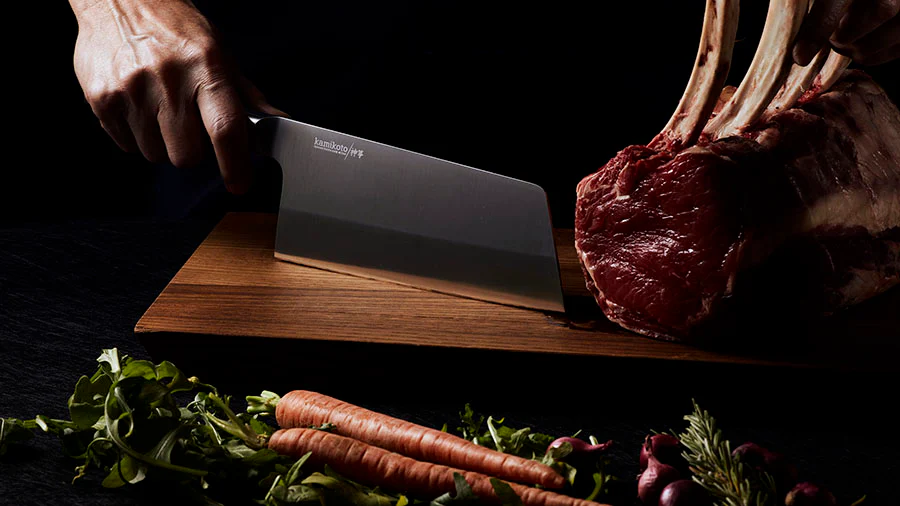A cleaver knife is a powerful and versatile tool in the kitchen, essential for tasks ranging from chopping through bones to slicing vegetables. Proper care and maintenance of your cleaver knife will ensure it remains sharp, safe, and durable for years to come. This guide will provide you with practical tips and tricks to keep your cleaver knife in top condition.
Cleaning Your Cleaver Knife
Hand Washing
To maintain the integrity of your cleaver knife, always wash it by hand. Follow these steps for proper cleaning:
- Immediate Cleaning: Rinse the knife under warm water immediately after use to prevent food particles from drying on the blade.
- Mild Soap: Use a mild dish soap and a soft sponge to clean the blade and handle. Avoid abrasive scrubbers that can scratch the surface.
- Rinse and Dry: Thoroughly rinse off all soap residue and dry the knife immediately with a soft cloth to prevent water spots and rust.
Avoiding the Dishwasher
Never put your cleaver knife in the dishwasher. The high heat and harsh detergents can damage both the blade and the handle, leading to dullness and potential warping.
Sharpening Your Cleaver Knife
Regular Sharpening
A sharp cleaver knife is safer and more efficient. Regular sharpening helps maintain the blade’s edge. Here are some methods:
- Whetstone: Use a whetstone for precise sharpening. Soak the stone in water for about 10 minutes, then sharpen the blade at a consistent angle, usually around 20 degrees.
- Sharpening Steel: A honing steel can be used to realign the blade’s edge between sharpening sessions. Hold the steel vertically and swipe the blade downwards at a 20-degree angle on each side.
- Professional Service: If you’re unsure about sharpening techniques, consider using a professional sharpening service to maintain the blade’s sharpness and integrity.
Honing
Honing is different from sharpening and should be done more frequently. It realigns the blade’s edge, ensuring it remains sharp between sharpening sessions. Use a honing steel or rod to gently realign the edge.
Proper Storage
Knife Block
Storing your cleaver in a knife block keeps the blade protected and easily accessible. Ensure the block is clean and dry to prevent moisture buildup.
Magnetic Strip
A magnetic strip allows for convenient and safe storage. Ensure the strip is strong enough to hold the cleaver securely and mount it away from moisture and heat sources.
Blade Guards
Blade guards or sheaths are ideal for protecting the knife when stored in a drawer. They prevent the blade from dulling and reduce the risk of accidents.
Handling and Usage Tips
Cutting Surfaces
Always use a proper cutting board, preferably made of wood or plastic. Avoid cutting on hard surfaces like glass, stone, or metal, which can dull or damage the blade.
Proper Technique
Use the cleaver knife with controlled and deliberate motions. Avoid excessive force, as this can damage the blade and increase the risk of injury. Let the weight of the cleaver do the work when cutting through bones or tough materials.
Avoiding Impact
Do not use the cleaver knife to pry open cans, jars, or other containers. This can chip or break the blade. Use the appropriate tools for non-cutting tasks.
Preventing Rust and Stains
Drying Immediately
After washing, dry the cleaver knife immediately to prevent rust and water spots. Pay special attention to the area where the blade meets the handle.
Oiling the Blade
For high carbon steel cleavers, apply a light coat of food-safe mineral oil to the blade periodically. This prevents rust and keeps the blade in good condition. Stainless steel blades also benefit from occasional oiling, especially in humid environments.
Conclusion
Proper care and maintenance of your cleaver knife ensure it remains a reliable and efficient tool in your kitchen. By following these tips for cleaning, sharpening, storage, and handling, you can extend the lifespan of your cleaver and keep it performing at its best. A well-maintained cleaver knife not only enhances your cooking experience but also ensures safety and precision in all your culinary tasks.










